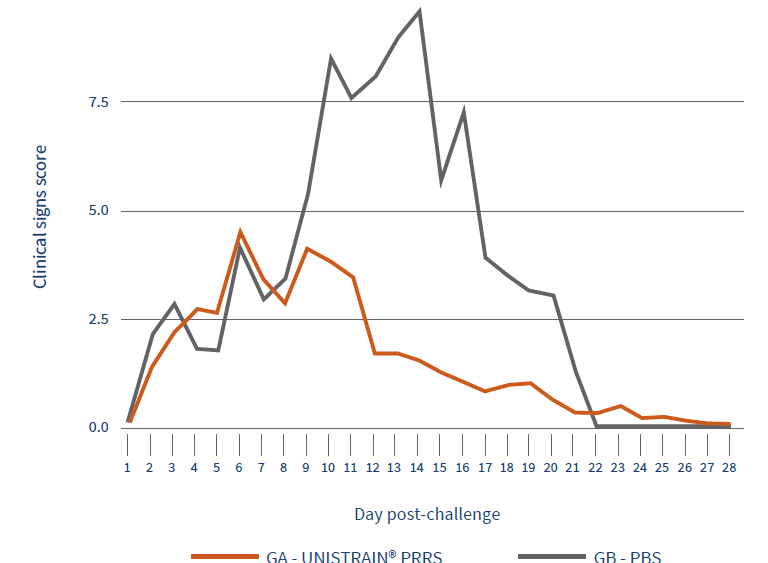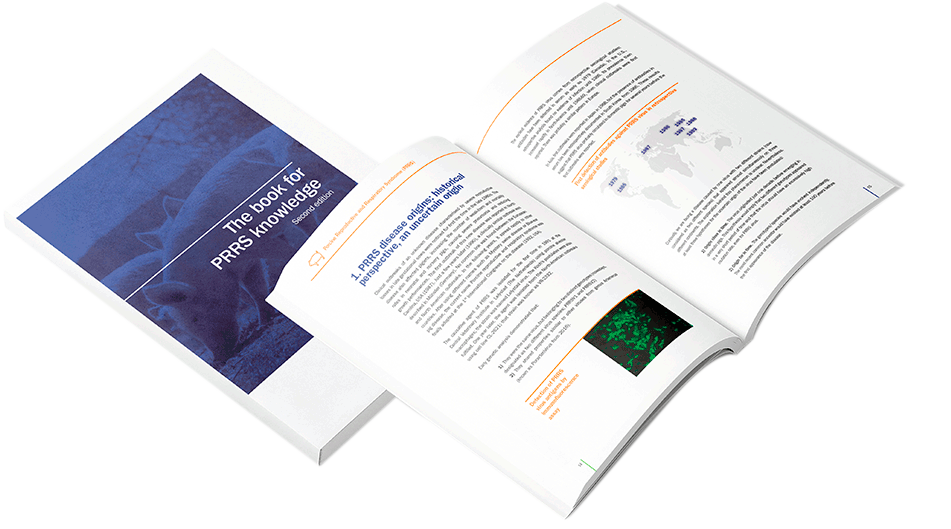The impact of PRRSV vaccination over a highly pathogenic strain: the case of Rosalia
Tiago Nunes1, Salvador Romero1, Lidia de Lucas1, Fernando de Mergelina1, Joel Miranda2
1Global Product Manager, HIPRA
2Global Franchise Manager, HIPRA
Introduction
The Porcine Reproductive and Respiratory Syndrome Virus (PRRSV) has been a significant cause of disease outbreaks since the late 1980s. Its effects on swine populations include reproductive failures, respiratory distress, slower growth rates, and increased mortality rates (Zimmerman et al. 2019). Over the years, due to the virus’s high mutation and recombination rates, more aggressive and highly pathogenic strains have emerged, causing even more severe outbreaks across different regions.
In 2020, a new highly pathogenic PRRSV strain, named Rosalia, was identified in Spain. During these years, the productive and economic impact of this strain has been devastating including high sow mortality, persistently elevated abortion rates (up to 27% over a span of 17 weeks), and dramatically high piglet mortality rates in nurseries, with peaks ranging from 28% to 50% (Martín-Valls et al. 2023).
While vaccinating both sows and piglets against PRRSV has been proven to reduce clinical symptoms and economic losses (Bouchet et al. 2022, Torrents et al. 2020, Linhares et al. 2012), the emergence of the Rosalia strain has posed a critical question: how effective are current vaccines in controlling outbreaks caused by this highly pathogenic variant?
Assessing Vaccination Efficacy Against the Rosalia Strain
A recent study by Cros et al. (2024) explored the efficacy of a Modified-Live Vaccine (MLV) in an experimental challenge against the Rosalia strain of PRRSV. The study involved 70 piglets (both PCR and ELISA negative to PRRSV), which were evenly divided into two groups. Group A, vaccinated intradermally (0.2 ml/dose) with UNISTRAIN® PRRS at 3 weeks of age, was compared to Group B, which received an intradermal placebo treatment (0.2 mL of PBS).
Five weeks after vaccination, both groups were intranasally exposed to the Rosalia strain (10e3.55 CCID50/animal). Clinical signs, including lethargy, anorexia, sneezing, coughing, nasal secretion, respiratory distress and skin discoloration were monitored and scored daily for 28 days post-challenge (scoring system adapted from Li et al, 2016; Prieto et al, 2011 and Martelli et al, 2009).
The results revealed a significant 57% reduction in clinical symptoms among the vaccinated animals. These animals showed significantly milder clinical symptoms, with a clinical score of 1.73, compared to 4.04 in the control group (p value <0.001). Additionally, the duration of clinical symptoms was notably shorter in the vaccinated group (Figure 1).
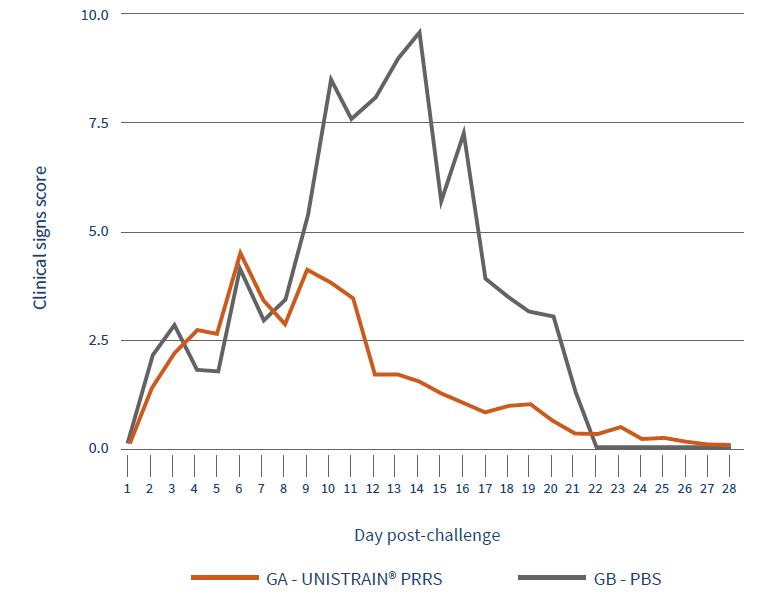
Figure 1 – Clinical signs score after challenge, by day and group.
Mortality rates were also recorded and demonstrated the vaccine’s protective effect, with an 89% reduction in the mortality of the vaccinated group: only 8.8% of the piglets succumbed to the virus, compared to a staggering 80% in the control group. Furthermore, all deaths in the vaccinated group occurred within the first 10 days post-challenge, while the mortality in the control group was prolonged until 20 days post-challenge (Figure 2).

Figure 2. Cumulative mortality in each group after HP-PRRSV1 challenge.
These results show a highly protective effect of UNISTRAIN® PRRS, being to our knowledge, the first published study where a vaccine clearly prevents the mortality associated with the infection by the Rosalia strain.
From the laboratory to the farm
On farms, various uncontrolled factors – such as the timing of infection, the presence of secondary infections, and environmental conditions – can influence the overall efficacy of vaccination. Therefore, to confirm the effectiveness of PRRS vaccination against the Rosalia strain, it is crucial to validate these results under real-world field conditions.
A field study by Meléndez et al. (2024a) evaluated the benefits of vaccination on a Wean-to-Finish farm positive to Rosalia and located in an area with high-density of swine farms. An intradermal vaccination program with HIPRADERMIC® was implemented at 3 weeks of age using UNISTRAIN® PRRS, and several key performance indicators (KPIs) were monitored before and after vaccination.
The results were remarkable (see Table 1). The vaccinated group showed a significant reduction in mortality (9.9% compared to 28.3% in the non-vaccinated group), along with improvements in average daily weight gain (ADWG) and feed conversion ratio (FCR). Additionally, medication costs were substantially reduced in 2.18€/pig.
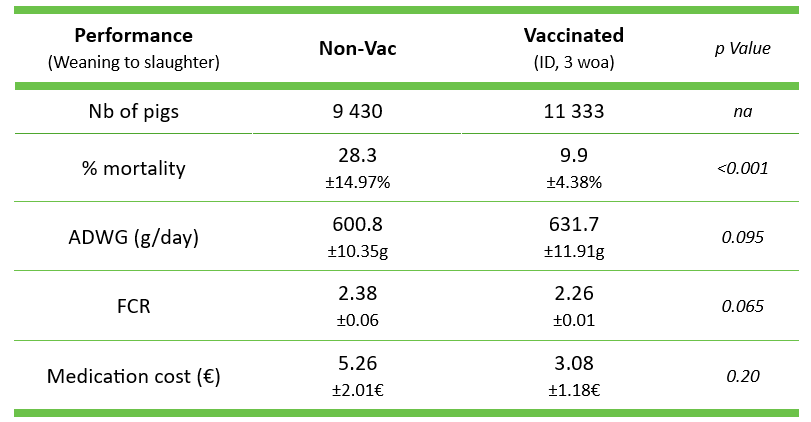
Table 1 – Comparison of KPI’s before and after the vaccination with UNISTRAIN® PRRS in a Rosalia-positive farm. Adapted from Meléndez et al, 2024(a).
A similar study was performed in another Wean-to-Finish farm (Meléndez et al; 2024b), with piglet intradermal vaccination at 3 weeks of age using UNISTRAIN® PRRS. Besides the mortality reduction, the significant improvement in growth performance led to a reduction of 1.82€/pig in the cost of production from wean-to-slaughter (table 2).
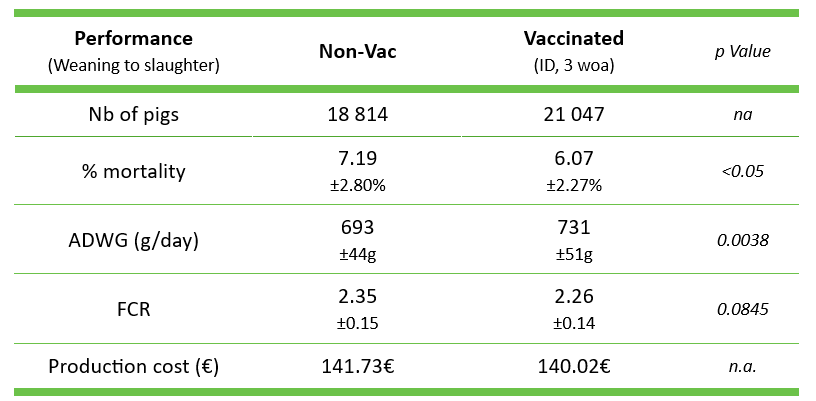
Table 2 – Comparison of KPI’s before and after the vaccination with UNISTRAIN® PRRS in a Rosalia-positive farm. Adapted from Meléndez et al, 2024(b).
A third field study conducted by Meléndez et al. (2024c) reinforced these findings, showing a significant and faster reduction of viral load in vaccinated animals on a Rosalia-positive farm, when compared with non-vaccinated animals: less 34% at 7 weeks post vaccination and less 63% at 12 weeks post-vaccination. A lower viral load is linked to reduced infection pressure, fewer clinical symptoms, and improved overall performance, further emphasizing the benefits of vaccination and aiding in the return to pre-outbreak productivity levels.
Conclusions
Despite the aggressive nature and severe outcomes associated with the Rosalia strain, vaccination with UNISTRAIN® PRRS has proven to be highly effective from both health and economical perspectives.
Vaccinating piglets not only significantly reduces clinical signs and mortality but also decreases the need for antimicrobial treatments and improves production performance, with a positive return-of-investment to the farmer. These results are coherent with previous studies where vaccination with UNISTRAIN® PRRS showed efficacy against other aggressive strains, such as Lena and type 2 highly pathogenic strains (Bonckaert et al, 2016; Roca et al, 2012).
The available data suggest that vaccinated animals cope better with the infection, exhibiting shorter illness periods and a faster return to normalcy. Vaccination remains a critical tool in managing Rosalia outbreaks, offering a practical and cost-effective solution to mitigate the impact of this highly pathogenic strain on swine production.
If you want to read more publications about PRRS: PRRS Control Publications
References
Bonckaert, C; Van der Meulen, K; Rodríguez-Ballará, I; Pedrazuel Sanz, R; Fenech Martinez, M; Nauwynck, HJ. “Modified-lived PRRSV subtype 1 vaccine UNISTRAIN PRRS provides a partial clinical and virological protection upon challenge with East European subtype 3 PRRSV strain Lena”. Porc Health Manag, 2016:12, 2
Bouchet, F; Berton, P; Teixeira-Costa, C; Lebret, A; Ardies, C; Brissonnier, M; Jeusselin, J; Chevance, C; Normand, V; Boulbria, G. “Economic impact of a porcine reproductive and respiratory syndrome (PRRS) stabilization program in a farrow-to-finish farm using mass vaccination with a modified live vaccine and strict biosecurity measures.” Proceedings – 13th European Symposium of Porcine Health Management. Budapest (HU): ECPHM, 2022. 60.
Cros, S; Pla, H; Simon-Grifé, M; Mergelina, F De; Fenech, M. “Assessment of the efficacy of a live attenuated vaccine against an experimental challenge with a highly virulent PRRSV1 strain.” Allen D. Leman Swine Conference. Saint Paul, MN (USA), 2024.
Li, Z; He, Y; Xu, X; Leng, X; Li, S; Wen, Y; Wang F; Xia, M; Cheng, S; Wu, H. Pathological and immunological characteristics of piglets infected experimentally with a HP-PRRSV TJ strain. BMC Vet Res 12, 230 (2016).
Linhares, DC; Cano, JP; Wetzell, T; Nerem, J; Torremorell, M; Dee, SA. “Effect of modified-live porcine reproductive and respiratory syndrome virus (PRRSv) vaccine on the shedding of wild-type virus from an infected population of growing pigs.” Vaccine, vol 30 (2), 2012: 407-413.
Martelli P, Gozio S, Ferrari L, Rosina S, Angelis E, Quintavalla C, Bottarelli E, Borghetti P. Efficacy of a modified live porcine reproductive and respiratory syndrome virus (PRRSV) vaccine in pigs naturally exposed to a heterologous European (Italian cluster) field strain: Clinical protection and cell-mediated immunity. Vaccine, Volume 27, Issue 28,2009, Pages 3788-3799.
Martín-Valls, GE; Cortey, M; Allepuz, A; Illas, F; Tello, M; Mateu, E. “Introduction of a PRRSV-1 strain of increased virulence in a pig production structure in Spain: virus evolution and impact on production.” Porc Health Manag, 2023: 9, 1.
Meléndez, A; Gayan, J; Sanchez, P; Nodar, L; Lucas, L De; Camarasa, J. “Evolución en el tiempo de la carga vírica de PRRS en un cebadero de animales vacunados y no vacunados infectados con una cepa campo.” XIII Congreso Associación Veterinários de Porcino de Aragón. Zaragoza (ES), 2024b.
Meléndez, A; Mitjavila, D; Escoda, A; Cons, Ll; Nodar, L; De Lucas, L; Camarasa, J. “Beneficios productivos y económicos a nivel de cebo de la vacunación intradérmica de lechones frente a PRRS en una granja española.” XIII Congreso Associación Veterinários de Porcino de Aragón. Zaragoza (ES), 2024c.
Meléndez, A; Nodar, L; Lucas, L De; Torrelles, H; Fernández, V; MArtínez, A; Balliellas, J; Camarasa, J. “Eficacia de la vacunación de lechones en una granja española infectada por cepa de alta virulencia de PRRS.” XIII Congreso Associación Veterinários de Porcino de Aragón. Zaragoza (ES), 2024a.
Prieto C, Martínez-Lobo FJ, Díez-Fuertes F, Aguilar-Calvo P, Simarro I, Castro JM. Immunisation of pigs with a major envelope protein sub-unit vaccine against porcine reproductive and respiratory syndrome virus (PRRSV) results in enhanced clinical disease following experimental challenge. Vet J. 2011 Sep;189(3):323-9. doi: 10.1016/j.tvjl.2010.07.010. Epub 2010 Aug 14. PMID: 20713312; PMCID: PMC7172774.
Roca, M; Gimeno, M; Bruguera, S; Segalés, J; Dìaz, I; Galindo-Cardiel, IJ; Martínez, E; Darwich, L; Fang, Y; Maldonado, J; March, R; Mateu, E. “Effects of challenge with a virulent genotype II strain of porcine reproductive and respiratory syndrome virus on piglets vaccinated with an attenuated genotype I strain vaccine”. The Veterinary Journal, 2012; 193(1):92-6
Torrents, D; Miranda, J; Nodar, L; Martos, A. “Improvement of productive parameters after piglet PRRS vaccination.” Proceedings – 2020 International Pig Veterinary Society Congress. Rio de Janeiro (BR): IPVS, 2020. 535.
Zimmerman, JJ; Dee, SA; Holtkamp, DJ; Murtaugh, MP; Stadejek, T; Stevenson, GW; Torremorell, M; Yang, H; Zhang, J. “Porcine Reproductive and Respiratory Syndrome Viruses (Porcine Arteriviruses).” In Diseases of Swine 11th Ed, by JJ Zimmerman, LA Karriker, A Ramirez, KJ Schwartz, GW Stevenson and J Zhang, 685-708. Hoboken (USA): Wiley Blackwell, 2019.

